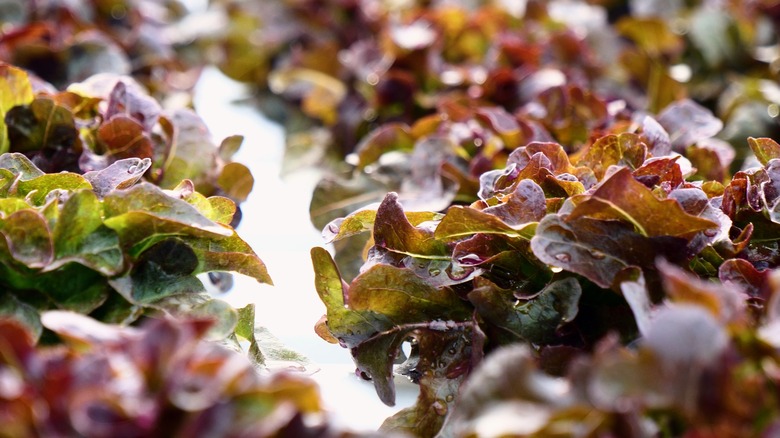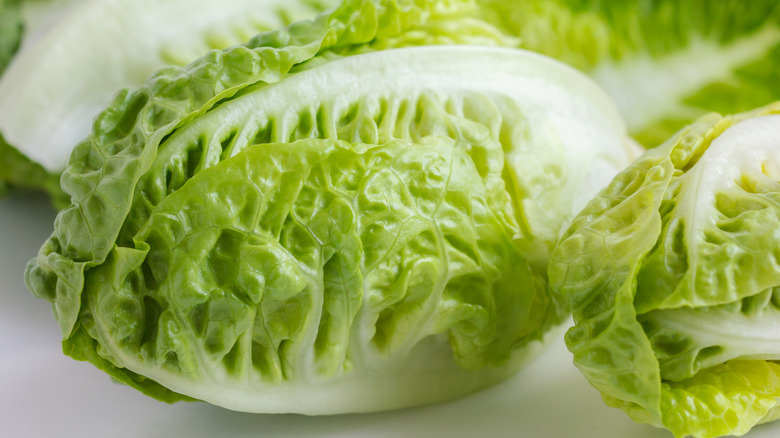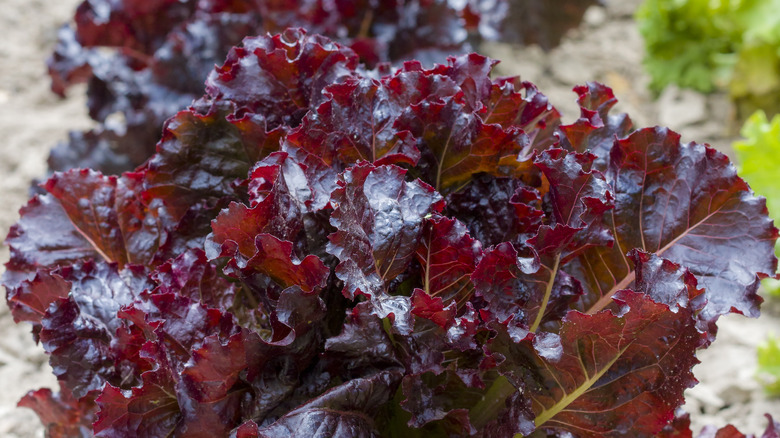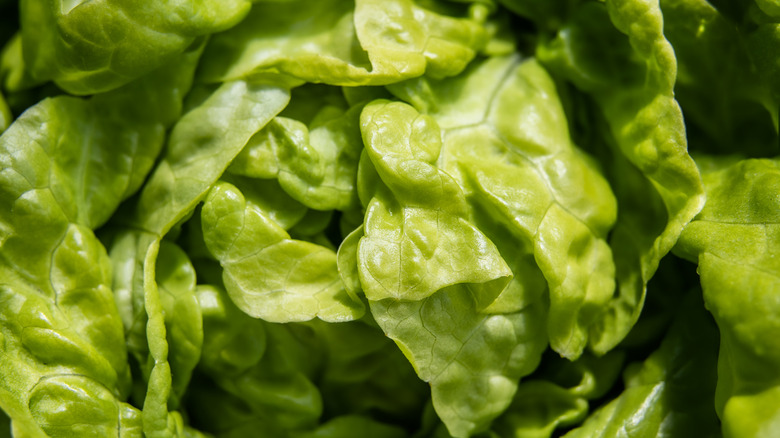Lettuces are easy for beginning gardeners to grow in containers, raised beds, or traditional garden beds. There are many delectable heirloom varieties with a range of textures and flavors, and I’ve listed 10 types that I recommend below. With wonderful names like Little gem, Buttercrunch, and Arctic king, you can grow these delicious lettuces from seed right after the last hard frost date or from starts purchased at nurseries to harvest fresh heirloom lettuce all summer.
But first, there are a few basic things to know about growing lettuce. It likes well-drained, fertile soil to which compost has been added and either full or partial sun. Too much bright sun and hot temperatures can cause lettuce to bolt, meaning it grows too fast and produces flowers and seeds. Bolting can cause home-grown lettuce to taste bitter, but there are ways to minimize this risk. One way is to keep lettuce shaded during the hottest part of the day. I do this by planting it next to a row of sunflowers that provide shade in the afternoon.
Lettuce can be harvested when the leaves are “baby” size or allowed to mature to full size leafy heads. The heat of summer makes growing lettuce challenging, so most gardeners wait until late summer to sow a second crop of seeds as temperatures begin to cool down. Try to harvest this vegetable as close as possible to when you will be using it, as it tastes best when it has been freshly-picked.
1. Red oak

Red oak refers to a variety of heirloom oakleaf lettuce that has many cultivars. Oakleaf lettuces have frilly leaves with scalloped edges that make them resemble oak leaves. The red oak lettuces are olive green with burgundy accents, with a very sweet taste and a buttery texture. Red oak lettuces have been found to have high levels of beneficial antioxidants. These lettuces make a wonderful base for fresh summer salads and are delicious in wraps and sandwiches. Some excellent red oak varieties to try include Cobham, Oscarde, Danyelle, Paradai, Red coral, and Vulcan.
2. Buttercrunch
True to its name, Buttercrunch lettuce has a sweet, buttery flavor and wonderful smooth texture in the outer leaves of spring green, with an interior head of lighter-colored, crisper leaves. This classic butterhead heirloom is well-loved for its diminutive size, which makes it easy to grow and also beautiful for dinner table presentations. It is slow to bolt and can tolerate the summer heat fairly well, and seeds can be sown every few weeks in summer for continual harvest. This lettuce tastes best if harvested in the morning and should be kept cool (but not refrigerated if possible) until serving.
3. Deer tongue
stockphotofan1/Shutterstock
The playful name of this lettuce variety refers to the slender, pointed leaves being shaped like a deer’s tongue. It is a loose-leaf variety, meaning it doesn’t form tight heads or rosettes like other lettuces but instead forms an attractive pointy pinwheel shape in the garden. Deer tongue lettuce comes in a number of cultivars, with both sprightly green and attractive red varieties. The flavor of Deer tongue lettuce is nutty and sweet, with a very tender texture. The flat leaves are great for sandwiches and wraps. The plants are generally vigorous and heat-tolerant.
4. Lollo rosso
Rut_Luecha/Shutterstock
This frilly heirloom lettuce looks like sparkling red rubies in the garden. Lollo rosso is one of a number of red lettuce cultivars bred for their brilliant color. These lettuces do not form heads or rosettes but instead put out branches from a central base, and leaves can be harvested singularly as needed. It has a crisp yet tender texture and a complex flavor profile: sweet and nutty with a slight hint of bitterness common in many greens. The curly, frilly leaves are excellent for salads as they hold onto dressings and toppings like seeds and nuts.
5. Flashy trout back
Danita Delimont/Shutterstock
Flashy trout back is one of several similar-looking cultivars, long known in Germany as “Forellenschluss” which means “speckled like a trout.” These colorful lettuces are bright apple green with dark red spots and really liven up salads with their unusual hues. This is a romaine type of lettuce, with smaller, looser heads than the romaines found in grocery stores. The leaves are sweet, crisp, and flavorful as “cut and come again” baby leaves or mature heads. This lettuce is cold hardy and does well late in the season as nights turn colder before frost.
6. Cimarron
sophiecat/Shutterstock
This robust heirloom romaine has bronze burgundy colored heads with tender, somewhat curly outer leaves and a crisp heart. Cimarron is said to be descended from similar varieties dating back to the 18th century, but seeds for the current cultivar were first marketed in 1980s. Still, a lettuce this delicious and hearty in summer heat may well have powerful ancestors. Cimarron is slow to bolt in summer but its coloring performs best in spring and fall crops. The firm, flavorful leaves hold up well for almost any culinary use.
7. Arctic king
Peter Turner Photography/Shutterstock
This butterhead type of heirloom lettuce forms lime green compact heads with tender leaves that are full of juicy, sweet flavor. Its name refers to its excellent cold-hardy nature. Arctic king does very well planted in early spring and keeps growing into late fall, even after light frost, providing the treat of fresh lettuce well into October. This plant grows at a medium rate and is usually ready for harvest within 60 to 70 days after seeds are sown. Arctic king performs best in a well-drained, loamy, neutral pH, slightly-sandy soil.
8. Little gem

Etiennevoss/Getty Images
The compact, pale green, elongated heads of Little gem are perfect for any dish calling for “hearts of romaine” or for making braised lettuces (as seen in the delightful 2024 French film “The Taste Of Things”). The current cultivar becoming popular in the U.S. is actually the same as the well-loved English heirloom variety Sucrine or Sugar cos. It has qualities of both butterhead and romaine lettuces, with a buttery feel and taste but a sturdy structure that lends itself to grilling and making lettuce wrap sandwiches. It grows best in full sun and matures in 45 to 50 days.
9. Merlot

Romanovskyy/Getty Images
Named for its deep garnet color reminiscent of the hearty wine, Merlot is a colorful recent heirloom leaf lettuce was brought over to America from Holland in the 1980s (sold in Europe under the name Galactic). Loaded with antioxidants and vitamin A with crisp, supple leaves and an earthy, herbaceous flavor, it’s a real jewel for the summer table. This one tastes best harvested young as baby lettuce leaves or a “cut and come again” variety. A fast grower, only 55 days from planting seed to harvest, Merlot is slow to bolt but benefits from light shade from afternoon sun in summer.
10. Tom thumb

sophiecat/Shutterstock
This variety is one of the oldest heirloom lettuces grown in North America, dating back to the 1830s, and is named for a well-loved children’s story. These diminutive lettuces grow to round heads only 4 or 5 inches across, making them perfect for individual salads. They’re also an excellent vegetable for a container garden, as they can be planted in window boxes or hanging baskets. This lettuce has lovely coloring (dark green outer leaves and pale green inner leaves), and an all around sweet, slightly-savory and delicate flavor. It grows quickly, providing full size (but tiny!) heads that can be harvested in 45 days.


